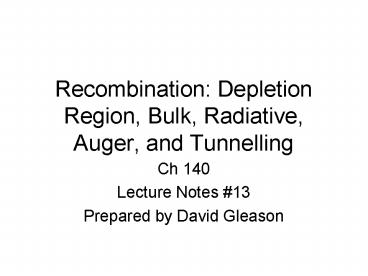Recombination: Depletion Region, Bulk, Radiative, Auger, and Tunnelling - PowerPoint PPT Presentation
Title:
Recombination: Depletion Region, Bulk, Radiative, Auger, and Tunnelling
Description:
Recombination: Depletion Region, Bulk, Radiative, Auger, and Tunnelling. Ch 140 ... Leads to LEDs, lasers, ect. Radiative Recombination Current ... – PowerPoint PPT presentation
Number of Views:273
Avg rating:3.0/5.0
Title: Recombination: Depletion Region, Bulk, Radiative, Auger, and Tunnelling
1
Recombination Depletion Region, Bulk, Radiative,
Auger, and Tunnelling
- Ch 140
- Lecture Notes 13
- Prepared by David Gleason
2
Review of Depletion Region Recombination
- We assume
- Flat Quantum Fermi Levels
- Requires that the fastest recombination rate is
slow with respect to diffusion - kn kp ??
- There are an even distribution of traps where ?
does not depend on x - This leads to
3
Review of Depletion Region Recombination (cont.)
- We also have
- and JD/R qUtotal
- So
4
Quasi-Neutral Region
- The Quasi-neutral region is defined as a region
of the semiconductor with an uneven distribution
of carriers in a region of flat bands - As pictured, the holes will diffuse away from w
into the bulk where they will recombine
w
w
Ef,n
Ef,p
h
h
h
h
h
h
Quasi-Neutral Region
5
Bulk Recombination
- At steady state
- using Ficks 1st Law
- and Ficks 2nd Law
- We have
6
Bulk Recombination (cont.)
To solve this we must first establish some
boundary conditions
1.
2.
3.
Solving for p(x) yields
Where is the diffusion
length
7
- The bulk recombination current can be determined
by - JBR q flux
- where the flux here is for all carriers at any
point in the flat band region - This is solved easiest at w since there there is
no electron movement to consider. At other
values of x - JBR-q fluxholesq fluxelectrons
- At xw this simplifies to
- Solving this and evaluating at xw recognizing
that the last term simplifies - We have
8
- From
- We can substitute
- To get
- This is the bulk region recombination
9
Radiative Recombination
- Assume a perfect semiconductor crystal
- No surface state recombination
- No depletion region recombination (? is very
small) - No bulk recombination (Lp is very big)
- Generate carriers through light absorption or
thermal excitation - Carriers diffuse until finally they recombine in
the inverse of the absorption reaction - Light is emitted with h? Eg
h?
10
Radiative Recombination (cont.)
- This process has been ignored until now because
for indirect band gap semiconductors the carrier
lifetime due to radiative recombination is really
long. - 99.9 of bulk recombination in Si and Ge will
occur across trap states - For direct gap semiconductors, including GaAs and
porous Si, radiative recombination is more
competitive - Leads to LEDs, lasers, ect.
11
Radiative Recombination Current
- Rate of electron recombination given by
- At equilibrium
- This expression can be plugged into the rate
equation away from equilibrium to give - And finally
12
Determination of kr from the absorption spectra
- Indirect semiconductors can not be made pure
enough to emit, so kr must be calculated from the
absorption spectra - At equilibrium in a perfect sample, the rate of
thermal absorption must equal the rate of
radiative recombination because they are inverse
processes - The thermal absorption is given by the overlap
between the blackbody curve at temperature T and
the absorption spectra at temperature T
13
Determination of kr from the absorption spectra
GaAs absorption spectra
Si absorption spectra
300K Blackbody
Photons absorbed by Si
Photons absorbed by GaAs
Eg GaAs
Eg Si
Note that even though Si has a lower Eg than
GaAs, less light is absorbed due to the shape of
the absorption spectra caused by the indirect
band gap of Si. At equilibrium, the amount
absorbed is equal to that emitted through
radiative recombination, so we can calculate kr,
which is sometimes called B, and has units of
cm4s-1.
14
Auger Recombination
- Pronounced or
- Occurs at very high injection or doping
conditions - This is a 3 body process whereby two majority
carriers collide - One looses energy Eg and combines with a minority
carrier - The other gains energy Eg, which it subsequently
looses through thermalization
15
Auger Recombination (cont.)
heat
- For n-type
- Auger lifetime
- Gn recombination rate
- For p-type
- Auger lifetime
- Gp recombination rate
- Gp ? 2x10-31 cm6/s for Si at room temperature
- The dependence is on n or p, and therefore
depends on the doping or excitation level
Eg
e-
e-
-Eg
h
e-
-Eg
h
h
Eg
heat
16
Tunneling Current
- Tunneling is only important at high high dopant
densities and low temperatures - The tunneling probability is given by
- The tunneling probability is temperature
independent, and since most other currents
(thermionic emission) are highly temperature
dependent it is only seen at low temps
where
Ratio of tunneling current to thermionic current
for Si-Au barrier taken from Sze p. 264
17
Summary of Recombination
- Bulk
- Depletion Region
- Thermionic
- Radiative
- Auger
- Tunneling
18
Summary of Recombination (cont.)
- Bulk
- A1, depends ND
- Jo proportional to exp(-Eg/kT)
- Depletion Region
- A2
- Thermionic
- A1, does not depend on ND
- Jo proportional to exp(-q?b/kT)
- Radiative
- Insignificant for indirect gap semiconductors,
- Strictly depends on excess carriers
- Auger
- Only at really high carrier concentrations
- Tunneling
- Only significant at low T and high ND or NA
- Constant with temperature































